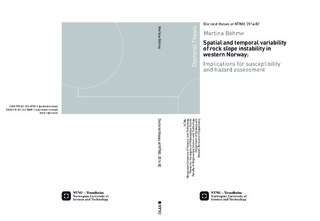| dc.contributor.author | Böhme, Martina | nb_NO |
| dc.date.accessioned | 2014-12-19T11:56:44Z | |
| dc.date.available | 2014-12-19T11:56:44Z | |
| dc.date.created | 2014-03-06 | nb_NO |
| dc.date.issued | 2014 | nb_NO |
| dc.identifier | 703333 | nb_NO |
| dc.identifier.isbn | 978-82-326-0088-5 (printed version) | nb_NO |
| dc.identifier.uri | http://hdl.handle.net/11250/236254 | |
| dc.description.abstract | Rock slope failures form a frequent hazard to many populated mountain regions. Especially in western Norway, the topographical and meteorological characteristics increase the vulnerability for rock slope failures. A major focus for studies in Norway is to eciently nd and investigate possible future rock slope failures in order to prevent extensive humanitarian disasters. The determination of the critical parameters involved in the development of rock slope failures is crucial in order to optimize hazard recognition. In addition, a better understanding of the spatial and temporal variability of prehistoric and historic rock slope failures as well as present day rock slope instabilities will optimize monitoring and further research on the susceptibility for future rock slope failures.
The primary aim of this study is to investigate the spatial and temporal distribution of rock slope instabilities within western Norway. It is further aimed to determine the controlling parameters on the development of rock slope instabilities within the study region. The implemented approaches range from regional scale statistical analyses towards site specic numerical modelling, while a focus is set on quantitative analyses.
Within this thesis the main controlling parameters are dened for rockfalls and rock slope instabilities on a regional scale for the entire county of Sogn & Fjordane, western Norway. It is demonstrated that always a combination of several parameters is necessary to destabilize a mountain side. Rockfalls have the strongest spatial relation to the presence of bare rock as well as landslide deposits, the degree of tectonic deformation and the geological lineament density. Large rock slope instabilities develop preferentially within relatively weak rock units, such as phyllites or weathered mac gneisses, and at convex slope breaks. Looking more into detail, a strong structural control is conrmed by numerical modelling for the unstable rock slope at Stampa.
Susceptibility and hazard are assessed at dierent scales and with dierent measures. Quantitative rockfall susceptibility is mapped on a regional scale for the entire county of Sogn & Fjordane based on the statistical analysis of a set of controlling factors. In addition, this statistical susceptibility model is combined with a physically based model, restricting the susceptibility map to areas that are steep enough to represent a potential rockfall source. This combination allows using road inventories, with registered impact points instead of release areas, for susceptibility modelling. In contrast, relative susceptibility and also hazard are assessed locally for single parts of the unstable rock slope at Stampa based on morphology and past activity. Present day annual expectable frequencies for rock slope failures of certain volume classes are determined for the Storfjord region in western Norway based on magnitude-frequency analyses. Furthermore, a semi quantitative hazard estimation is obtained for each potential instability based on a qualitative susceptibility assessment of each instability in this region.
This PhD thesis presents results of the rst attempts of quantitative statistical analyses of dierent inventories covering rock slope instabilities in Norway. It is shown that susceptibility and hazard can be assessed with dierent measures, forming the basis for further decisions regarding risk assessment and mitigation. | nb_NO |
| dc.language | eng | nb_NO |
| dc.publisher | Norges teknisk-naturvitenskapelige universitet, Fakultet for ingeniørvitenskap og teknologi, Institutt for geologi og bergteknikk | nb_NO |
| dc.relation.ispartofseries | Doktoravhandlinger ved NTNU, 1503-8181; 2014:82 | nb_NO |
| dc.relation.haspart | Böhme, M.; Derron, M.H; Jaboyedo, M.. Quantitative spatial analysis of rockfalls from road inventories - a combined statistical and physical model. . | nb_NO |
| dc.relation.haspart | Böhme, Martina; Saintot, Aline; Henderson, Iain H.C.; Henriksen, Helge; Hermanns, Reginald L.. Rock slope instabilities in Sogn and Fjordane County, Norway. Slope Tectonics - Geological Society of London Special Publication 351: 97-111, 2011. 10.1144/SP351.5. | nb_NO |
| dc.relation.haspart | Bohme, Martina; Hermanns, Reginald L.; Oppikofer, Thierry; Fischer, Luzia; Bunkholt, Halvor S. S.; Eiken, Trond; Pedrazzini, Andrea; Derron, Marc-Henri; Jaboyedoff, Michel; Blikra, Lars H.; Nilsen, Bjorn. Analyzing complex rock slope deformation at Stampa, western Norway, by integrating geomorphology, kinematics and numerical modeling. Engineering Geology. (ISSN 0013-7952). 154: 116-130, 2013. 10.1016/j.enggeo.2012.11.016. | nb_NO |
| dc.relation.haspart | Böhme, M.; Hermanns, R.L.; Fischer, L.; Oppikofer, T.; Bunkholt, H.S.S.; Derron, M.-H; Carrea, D.; Jaboyedo, M.; Eiken, T.. Detailed assessment of the deep-seated gravitational deformation at Stampa above Flåm, Norway. Proceedings of the 11th International& 2nd North American Symposium on Landslides - Landslides and Engineered Slopes. Protecting Society through Improved Understanding: 647-652, 2012. | nb_NO |
| dc.relation.haspart | Böhme, M.; Oppikofer, T.; Longva, O.; Jaboyedo, M.; Hermanns, R.L.; Derron, M.-H.. Analyses of past and present rock slope instabilities in a fjord valley: Implicationsfor hazard estimations.. . | nb_NO |
| dc.title | Spatial and temporal variability of rock slope instability in western Norway:: Implications for susceptibility and hazard assessment | nb_NO |
| dc.type | Doctoral thesis | nb_NO |
| dc.contributor.department | Norges teknisk-naturvitenskapelige universitet, Fakultet for ingeniørvitenskap og teknologi, Institutt for geologi og bergteknikk | nb_NO |
| dc.description.degree | PhD i geologi og bergteknikk | nb_NO |
| dc.description.degree | PhD in Geology and Mineral Resources Engineering | en_GB |

